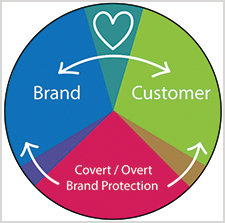Brand Protection That Doesn’t Negatively Impact Package Aesthetics
November 13, 2017
An expiration date on a package is perhaps one of the most easily recognized measures of brand protection. It serves its purpose of protecting both the brand and the customer.
For some brands an expiration date may be all that is needed to protect their relationship with their customers. But if your brand runs the risk of counterfeiting, product theft, diversion, or tampering, there may be several layers of ‘Yes/No’ protection that are required to build brand trust, customer loyalty, and ultimately everything you have invested in your product.
On-Packaging Security Solutions
Today’s packaging security solutions can be built into the aesthetics of your brand packaging. They can be designed to be intuitive and trustworthy and don’t have to disrupt the impact of your brand aesthetics or the customers experience with your product. Some materials and inks can even enhance the creative expression of your brand. With the variety of inks, substrates, and technology that are available we can create an experience that is effective and unique to your brand or an individual product. Whatever level of brand security you determine is needed, it should protect the integrity and authenticity of your brand, protect your relationship with your customer, and the life of your brand.
Overt brand protection
Overt layers of brand protection are open and visible to anyone. They can be cost effective for brand owners and an easy way for consumers to say ‘Yes’ to your product. Because they are visible to anyone, overt levels of protection can also be most vulnerable to counterfeit reproduction.
Overt brand security options can be designed into your existing brand elements and existing packaging. Holograms are designed to highlight the color shifting surface of your packaging and attract the eye of your customers. Color changing inks are available in a wide variety of colors and can be activated by a number of triggers including temperature, sunlight, UV light, water, or pressure. Design elements can also be incorporated into your packaging that can signal evidence of tampering, such as micro-perforations and tamper-evident labels.
Covert brand protection
Covert layers of brand protection are not openly acknowledged or displayed and can provide even more protection especially for anti-counterfeiting, brand authenticity, or if your brand runs the risk of a product recall. Covert security technologies are typically managed and monitored by the brand team and tools such as readers are often required. They can be layered with overt solutions for maximum protection and deterrence.
Covert brand security can include UV fluorescing inks, IR inks (glow only at specific IR wavelengths). Taggent inks can be incorporated into your graphics and are invisible to the naked eye, authenticated only with special equipment and are extremely difficult to reverse engineer. For the highest level of covert security available DNA forensic inks can be customized exclusively for you and are incorporated into your ink formulations.
Digital solutions can offer both overt and covert levels of brand security. Near-field communication (NFC) is a contactless technology which is a way for your NFC enabled smartphone to exchange information with items embedded with a NFC chip in proximity. Digital watermarking can be printed into your brand packaging graphics and allows you to track, trace, and authenticate a package in real time. When digital watermarks are serialized (one unique watermark per package) this may be your best bet to keep track of your product, measure and prevent loss, and identify purchasing behaviors with your customers. Brand managers and marketing teams have access to customer data to track customer trends, create unique campaigns for new product launches or even develop specific campaigns unique to different regions where the products are sold.
Brand Integrity: Selecting the Right Solutions
Your brand packaging is an extension of the brand experience, memories, and stories. Here’s a few questions to share with your brand team in order to determine what level of brand protection is needed to build trust, positive experiences, and a long-term relationship with your customers.
- What is the risk involved with a product recall or failure? How long would it take you to recover?
- How much are you willing to invest to safeguard your customers and brand equity?
- What level of protection is expected from your customers? At what point does it become a barrier from purchasing behaviors or brand trust?
- How loyal are your current customers? What would it cost to establish new customers?
Ultimately, you don’t need to choose between brand aesthetics and brand security. The choice lies in determining what options work best to strengthen the relationship and trust between your brand and customers. Applying the right amount of brand protection will help you deliver tangible solutions to protecting product recall, authentication, anti-counterfeit and gray market. It will also help you hold true to your brand values, brand ideals, and ultimately the relationship you have with your customer. Customers who choose to engage with your product and have a positive experience with your brand will confidently, and continually, say ‘Yes’ to your product.
If you are interested in more on the topic of Brand Security, click here to see Inland’s Pack Expo 2017 Innovation Stage presentation recording where we go into more detail on overt and covert brand security options.



